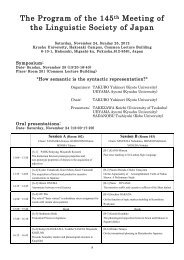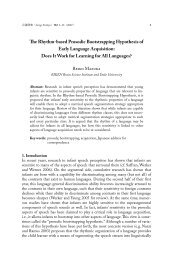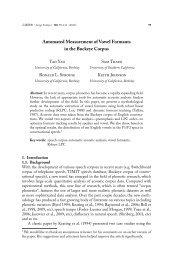第117åæ¥æ¬è§£åå¦ä¼ç·ä¼ã»å ¨å½å¦è¡éä¼ è¬æ¼ããã°ã©ã ã»æé²é PDF ...
第117åæ¥æ¬è§£åå¦ä¼ç·ä¼ã»å ¨å½å¦è¡éä¼ è¬æ¼ããã°ã©ã ã»æé²é PDF ...
第117åæ¥æ¬è§£åå¦ä¼ç·ä¼ã»å ¨å½å¦è¡éä¼ è¬æ¼ããã°ã©ã ã»æé²é PDF ...
You also want an ePaper? Increase the reach of your titles
YUMPU automatically turns print PDFs into web optimized ePapers that Google loves.
117 109<br />
OGAMII<br />
BrdU <br />
<br />
<br />
<br />
Labelretaining cells<br />
LRCs <br />
ICR 3 BrdU 5 <br />
<br />
1 2 EDTA Nestin<br />
OPN BrdU TUNEL in situ <br />
Dsp <br />
1 TUNEL <br />
<br />
LRCs 35 <br />
Nestin LRCs <br />
Nestin 7 <br />
OPN <br />
DspmRNA <br />
LRCs <br />
<br />
OPN <br />
<br />
OGAMIII<br />
Cx NFATc <br />
1 2 1 3<br />
1<br />
2 3 <br />
Cx45 <br />
Cx45 <br />
Cx45 <br />
<br />
<br />
Cx45 <br />
<br />
Cx45 <br />
Cx45 <br />
Cx45 <br />
<br />
NFATc <br />
NFATc VEGF <br />
Cx45 <br />
NFATc <br />
<br />
<br />
OGAMIII<br />
FGF <br />
1 2<br />
1<br />
2 <br />
GDNF <br />
<br />
FGF <br />
1213 <br />
FGFcanonical, 15 FGF 7 <br />
FGF 3 <br />
GDNF Ret, GFRα1<br />
FGF5, FGF9,<br />
FGF17, FGF18, FGF22 FGF9 <br />
10 FGF9 <br />
Ret, GFRα1 GDNF <br />
<br />
FGF9 FGF9 <br />
FGF <br />
FGF9 <br />
FGF9 <br />
<br />
<br />
OGAMIII<br />
An attempt to identify novel ciliary genes by database comparison<br />
<br />
<br />
Cilia and flagella are hairlike organelles that project from the cell surface and<br />
have been implicated in a diversity of cell functions. Although a number of<br />
putative ciliary genes have been identified by several global analyses, little is<br />
known about the functions of these genes. To gain a better understanding of ciliary<br />
biology, we selected ciliary candidate genes from comprehensive ciliary protein<br />
data sets, named ciliome, and analyzed their antisenseknockdown phenotypes<br />
in medaka embryos. To maximize quality hits, we selected genes expressing<br />
in ciliary organs based on the zebrafish expression database. Comparing the<br />
expression among 5 ciliary organs, we found that 18 genes are commonly<br />
expressed in more than 4 organs out of the above 5. Comparing these genes with<br />
ciliome database, 5 out of the 18 genes were recorded in ciliome database. We<br />
therefore preliminary examined the medaka antisenseknockdown phenotypes of<br />
2 of the 5 genes. One revealed hydrocephalous and the other showed cystic kidney<br />
phenotype: both of which are ciliadefective phenotypes. This data suggests that<br />
our strategy is a promising approach to understanding various roles for ciliome<br />
proteins.<br />
OHAMI<br />
<br />
1 1 2 1<br />
1<br />
2 <br />
<br />
<br />
<br />
<br />
<br />
<br />
<br />
<br />
58 <br />
Rmax <br />
10 mm <br />
<br />
<br />
<br />
<br />
27 <br />
<br />
<br />
<br />
<br />
OHAMI<br />
On the phylogeny of the zygomatic arch, and its relationships among<br />
foramina and the bony wall of the orbit<br />
1,3 1 2 2 3 <br />
3 4 4 4 4<br />
1<br />
Kanagawa Dental College, 2 Edogawa Hospital, 3 Dept. Radiology, Yokohama City<br />
Univ. Sch. Med., 4 Dept. Neurosurgery, Yokohama City Univ. Sch. Med.<br />
The existence of the arcus zygomaticus is a characteristic of mammalian skulls.<br />
The arches provide surface for the masseter muscle to attach, and the canalis<br />
zygomaticus stores the passage of the zygomatic nerve. Romer & Parsons<br />
surmised that the arches are a last remnant of the former lateral walls of the<br />
reptilian skull. Only Simiiformes Catarrhini and Platyrrhini has the perfect bony<br />
orbital wall, whereas the Prosimii, Perissodactyla, and Artiodactyla lost the rear<br />
wall and floorbord of the bony orbit, and the Carnivora lost the lateral posterior<br />
bony wall of the orbit. However Hystricomorpha has another pair of arches on<br />
the lateral walls of the greatly enlarged infraorbital foramen. This structure seems<br />
to us a new frontal and rear expansion and reinforcement of the zygomatic arch.<br />
In the Simiiformes, the Fossa temporalis has a relatively large volume so that the<br />
brain case has become a high structure. Therefore it was not necessary for the<br />
zygomatic arch to enlarge in front and behind.







